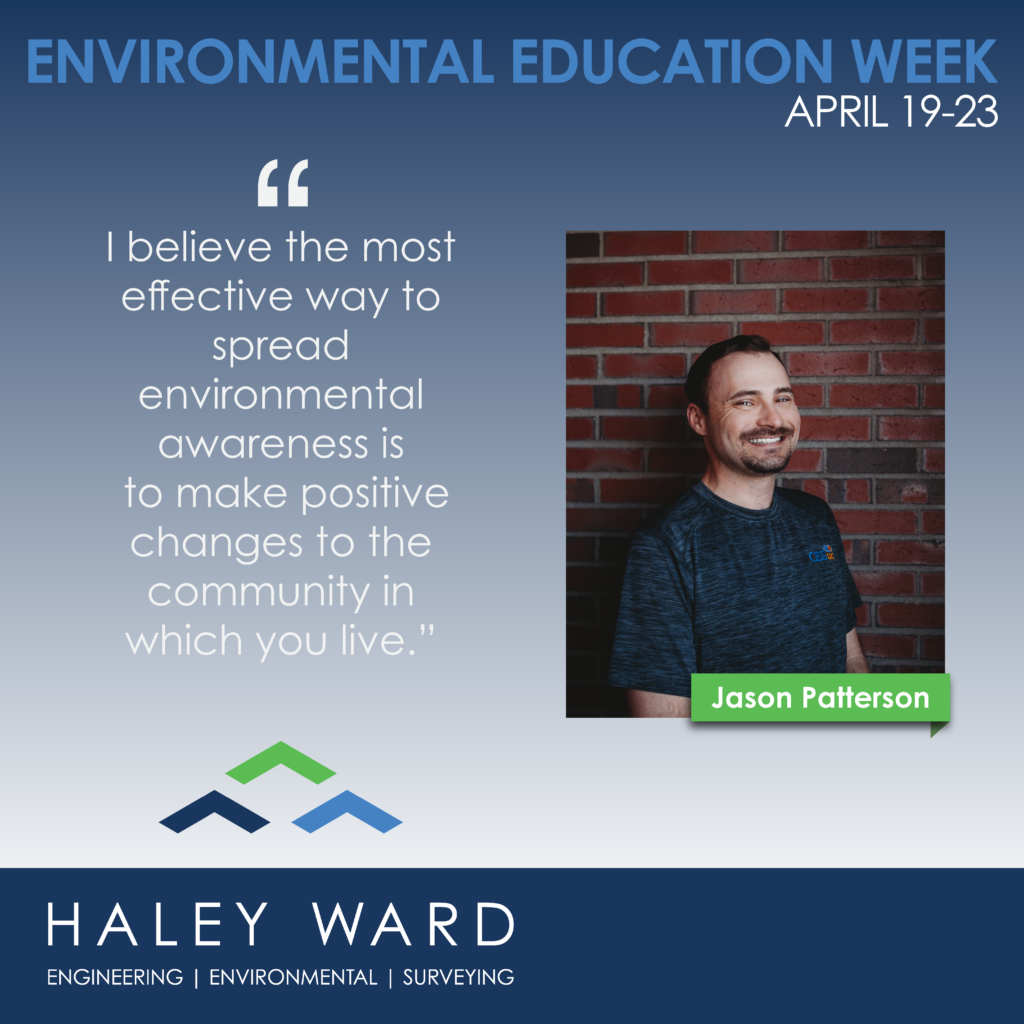Environmental Education Week: Interview with Jason Patterson

National Environmental Education Week (EE Week) is the nation’s largest celebration of environmental education! Throughout the week, we will be featuring a different environmental professional each day to gain some insight on why EE Week is important to them.
Today we are featuring Project Scientist Jason Patterson
Why do you feel that it is important for young people to be educated in the environmental sciences?
I believe that an education in environmental sciences is critical to understanding new and ongoing challenges faced by many sectors (insurance, engineering, municipal planning, etc..). To develop solutions that work today, and in 20 years from now, a basic understanding of why and how the environment is changing is needed. As the world population grows, these issues will only become more visible and many of today’s students will be asked for solutions.
What does being a “Good Citizen to the environment” mean to you?
A “Good Citizen to the Environment” is an individual that reduces their impacts to the natural world in the greatest ways practicable to them. Being conscious of individual effects to the environment is a first step in recognizing costly and environmentally detrimental effects.
If a young person wanted to do something at home to spread environmental awareness, what would you suggest?
I believe the most effective way to spread environmental awareness is to make positive changes to the community in which you live. Roadside clean-ups, stream clean-ups, creating trail networks, or addressing stormwater concerns are great projects that can be completed collectively or individually. Communicating why the changes are necessary and how they will benefit the community are great bridges to people who may be otherwise hesitant to spend additional time or money on issues and hardships that they have become accustomed to living with.
Why do you feel that it is important to start introducing Environmental STEM activities in the classroom at a young age?
The introduction of Environmental STEM activities to students early on in their education is so valuable because it provides students with issues and problems that, one-day society will be asking them to solve. Environmental solutions, like many of today’s societal problems will require a multi-disciplinary approach. Introducing students early will essentially plant-the-seed, giving them time throughout their education to develop possible solutions.
What made you decide to pursue a career in the environmental sciences?
As I progressed through college, I found environmental science extremely interesting because of the inter-connectivity of the natural world. Small chemical, physical or biological changes and those interactions can have enormous impacts over time and become visible on a macro-scale. We are constantly finding solutions to help the natural world recover to a healthier state.
What is one little change that someone can do to help the environment that ends up making a big difference?
One way that a person can make a big impact to the environment is to trust and advocate for science. As they will learn, science is not an opinion. Believing in scientific facts and advocating for truths that are represented by data accumulated over decades, in my opinion is the best way to make a big change. Centuries have gone into developing the scientific process for the purpose of providing objective data for people to understand the natural world and to base policies and decisions on.
Think locally: If you were a teacher, where would you take your students to learn about the environment and why?
In my opinion, a great place to take students to learn about the environment would be a Vernal Pool. Not only are vernal pools abundant throughout Maine, but they are teaming with life during the springtime. Much like a watering-hole in the Serengeti, Vernal Pools are areas for amphibians to congregate at, and breed following a long, cold winter in the Northeast. Dozens of egg masses, as well as salamanders, turtles, and the chorusing of frogs, are all possibilities at a vernal pool. Hands-on learning can spark interest in the students and provide a knowledge base of these important and delicate ecological features.
What has been your favorite environmental project that you have been on for Haley Ward?
My favorite project that I have worked on at Haley Ward was the construction of the Howland Dam Bypass Channel. The Bypass Channel was created on behalf of the Penobscot River Restoration Trust to facilitate the re-introduction of Atlantic Salmon to the Penobscot River Basin. It was incredibly satisfying knowing that my education led me to a company like Haley Ward, that was committed to the revitalization of a major river basin, in Maine. The project not only developed my understanding of the steps involved in a remediation and restoration project, but it also cultivated and improved my communication skills while coordinating with engineers, contractors, clients, and the community.